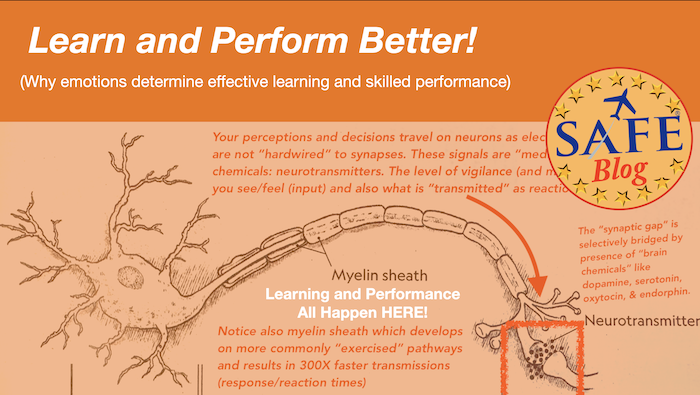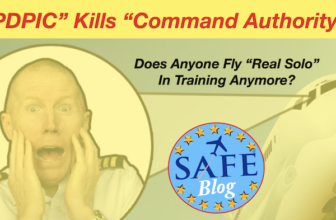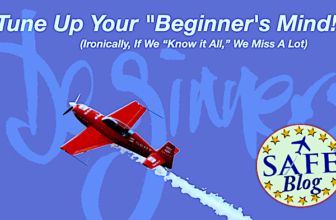
Here are some critical take-aways from our fourth SAFE CFI-PRO™ Webinar on superior teaching, learning, and performance. See our SAFE YouTube channel for other shows.
We Learn Continuously: “Implicit Learning”
 Every parent knows that kids see/learn everything (intentional or not): “Do as I say not as I do…” Flight students also learn continuously. The “intended lesson” is prepared and carefully presented. This is explicit (intentional) learning; we have specific content we are trying to convey. But the human mind also “learns and imports” continuously during everyday experience – internalizing good and bad “lessons.” This subconscious learning is called “implicit” learning (unintentional). This “hidden learning” has to be monitored even more carefully by the educator (and by any pilot or person seeking improvement). We can easily internalize bad habits or incorrect knowledge (watching those crazy aviation YouTubes or frequenting conspiracy websites). Every educator should curate their students’ online experience to the greatest degree possible (cure misinformation)
Every parent knows that kids see/learn everything (intentional or not): “Do as I say not as I do…” Flight students also learn continuously. The “intended lesson” is prepared and carefully presented. This is explicit (intentional) learning; we have specific content we are trying to convey. But the human mind also “learns and imports” continuously during everyday experience – internalizing good and bad “lessons.” This subconscious learning is called “implicit” learning (unintentional). This “hidden learning” has to be monitored even more carefully by the educator (and by any pilot or person seeking improvement). We can easily internalize bad habits or incorrect knowledge (watching those crazy aviation YouTubes or frequenting conspiracy websites). Every educator should curate their students’ online experience to the greatest degree possible (cure misinformation)
Our minds continuously import bad habits and biases without our conscious knowledge or intervention (your environment is critical). These unintentional “scripts” become “subconscious SOPs.” These hidden responses surprise every person – the things you say or do that you never consciously intended! These “subconscious scripts” are often embedded when we do not intend to be “learning” – this is how “normalizing“ happens. This is the reason “over-learning” is so important in aviation.
 Implicit (hidden) learning (and biases) are easily revealed with the “Implicit Association Test.” This clever test gauges your reactions in under 200 milliseconds before the conscious, thoughtful mind has time to mediate and modify the responses. This test has been on Harvard’s website for the last 10 years, with millions of responses. Read “Hidden Brain” for a very revealing exposé of this inner world. Knowledge of this hidden system is vital for a successful educator.
Implicit (hidden) learning (and biases) are easily revealed with the “Implicit Association Test.” This clever test gauges your reactions in under 200 milliseconds before the conscious, thoughtful mind has time to mediate and modify the responses. This test has been on Harvard’s website for the last 10 years, with millions of responses. Read “Hidden Brain” for a very revealing exposé of this inner world. Knowledge of this hidden system is vital for a successful educator.
Dual Human Operating Systems
 We also function in daily life in these same dual-levels of intentional/aware and unintentional/subconscious. The majority of our existence is automatic action (See “Eyes Wide Open“). From breathing and heartbeat to “normal daily life” lots of what we do runs according to automated scripts. And this is where unintentional/subconscious mental scripting often runs the whole show. Many previous SAFE blogs
We also function in daily life in these same dual-levels of intentional/aware and unintentional/subconscious. The majority of our existence is automatic action (See “Eyes Wide Open“). From breathing and heartbeat to “normal daily life” lots of what we do runs according to automated scripts. And this is where unintentional/subconscious mental scripting often runs the whole show. Many previous SAFE blogs  have emphasized the critical need for conscious awareness in piloting; situational awareness. We must be aware and vigilant (Code Yellow) for critical phases of flight (not sleepwalking)! Our human monitoring system goes quickly into “screen-saver mode” with the boring continuous inputs (cruise flight).
have emphasized the critical need for conscious awareness in piloting; situational awareness. We must be aware and vigilant (Code Yellow) for critical phases of flight (not sleepwalking)! Our human monitoring system goes quickly into “screen-saver mode” with the boring continuous inputs (cruise flight).
the unconscious mind is responsible for processing a vast amount of information that we are not consciously aware of, including sensory input, memories, and emotions… we often make decisions based on unconscious influences without even realizing it. Hidden Brain
We Are Not “Hardwired:” Learning and Performance are “Emotionally Dependent!”
 We tend to believe that once a habit, skill, or behavior is practiced and reinforced it is reliable and repeatable. But all this data (input and output) travels on neurons in the body. Though these signals are electrically transmitted (religiously repeatable), but these signals are also “chemically biased” at the “synaptic gap (cleft)” The presence or absence of the proper brain chemicals – neuro-transmitters – dramatically affects the resulting behavior (downstream) or learning (upstream). This is why the correct “environment and mood” (trust/honesty mentioned in “Learning Zone”) is
We tend to believe that once a habit, skill, or behavior is practiced and reinforced it is reliable and repeatable. But all this data (input and output) travels on neurons in the body. Though these signals are electrically transmitted (religiously repeatable), but these signals are also “chemically biased” at the “synaptic gap (cleft)” The presence or absence of the proper brain chemicals – neuro-transmitters – dramatically affects the resulting behavior (downstream) or learning (upstream). This is why the correct “environment and mood” (trust/honesty mentioned in “Learning Zone”) is  so essential for educational effectiveness. It is also why fear is such a poison to effective learning: the “synaptic gap” blocks any effective benefit. This “chemical biasing” is why the “synaptic gap” is the target for most “mind-altering” drugs and anti-depressants (Ketamine or Zoloft, and SSRIs). These drugs change the transmission rate at the synaptic gap (cleft) with amazing behavioral results. Similarly, a savvy educator creates these same changes at the “synaptic gap” by altering the environment – honesty and trust rather than fear – to achieve a positive learning potential. Repeated transmission at the synaptic gap leads to Long-Term Potentiation (an enduring enhancement of synaptic strength) which is the current theory of how enduring learning occurs. Enhanced myelination (through practice in the “struggle zone”) also increases signal speed and strength – learning. (See The Talent Code).
so essential for educational effectiveness. It is also why fear is such a poison to effective learning: the “synaptic gap” blocks any effective benefit. This “chemical biasing” is why the “synaptic gap” is the target for most “mind-altering” drugs and anti-depressants (Ketamine or Zoloft, and SSRIs). These drugs change the transmission rate at the synaptic gap (cleft) with amazing behavioral results. Similarly, a savvy educator creates these same changes at the “synaptic gap” by altering the environment – honesty and trust rather than fear – to achieve a positive learning potential. Repeated transmission at the synaptic gap leads to Long-Term Potentiation (an enduring enhancement of synaptic strength) which is the current theory of how enduring learning occurs. Enhanced myelination (through practice in the “struggle zone”) also increases signal speed and strength – learning. (See The Talent Code).
Struggle is not optional—it’s neurologically required: in order to get your skill circuit to fire optimally, you must by definition fire the circuit suboptimally; you must make mistakes and pay attention to those mistakes; you must slowly teach your circuit. You must also keep firing that circuit—i.e., practicing—in order to [build and] keep myelin functioning properly Talent Code by Daniel Coyle
Why “Reflective Analysis” Is Critical
 “Reflective Analysis” is the intentional review/reflect/redirect performed regularly after flight. This purges the mind of weird subconscious learning and habits and prevents “normalizing” (if we are honest with ourselves). The natural implicit learning cycle in our brains leads to a junkyard of ideas and procedures, some of which can be very dangerous: e.g. “magical thinking” in pilots. This combines our optimism bias with illusory superiority and confirmation bias. Our SAFE board candidate Gene Benson calls this the “Bias Bundle Bomb ”
“Reflective Analysis” is the intentional review/reflect/redirect performed regularly after flight. This purges the mind of weird subconscious learning and habits and prevents “normalizing” (if we are honest with ourselves). The natural implicit learning cycle in our brains leads to a junkyard of ideas and procedures, some of which can be very dangerous: e.g. “magical thinking” in pilots. This combines our optimism bias with illusory superiority and confirmation bias. Our SAFE board candidate Gene Benson calls this the “Bias Bundle Bomb ”
 The thoughtful, intentional mind has to consciously eradicate the crap that we internalize on a daily basis or weird biases and habits become our SOPs (both in flying and living). Awareness and reflection serve as a “mental detox” for the brain.
The thoughtful, intentional mind has to consciously eradicate the crap that we internalize on a daily basis or weird biases and habits become our SOPs (both in flying and living). Awareness and reflection serve as a “mental detox” for the brain.
All this information was part of our fourth CFI-PRO webinar (which was unfortunately not recorded – oops!) A future project is to provide this as a course for serious educators on the FAA Safety website. These basic structures in the brain and body are the physical reason why emotional intelligence and compassionate educators are the key to effective learning: proper awareness and mood (brain chemicals) are essential to our effective learning and performance. Fly safely out there (and often)!
 Join SAFE and get great benefits (1/3 off ForeFlight!) This supports our mission of increasing aviation safety by promoting excellence in education. Our FREE SAFE Toolkit App puts required pilot endorsements and experience requirements right on your smartphone and facilitates CFI+DPE teamwork. Our CFI insurance was developed by SAFE specifically for CFIs (and is the best value in the business).
Join SAFE and get great benefits (1/3 off ForeFlight!) This supports our mission of increasing aviation safety by promoting excellence in education. Our FREE SAFE Toolkit App puts required pilot endorsements and experience requirements right on your smartphone and facilitates CFI+DPE teamwork. Our CFI insurance was developed by SAFE specifically for CFIs (and is the best value in the business).
Discover more from reviewer4you.com
Subscribe to get the latest posts to your email.





